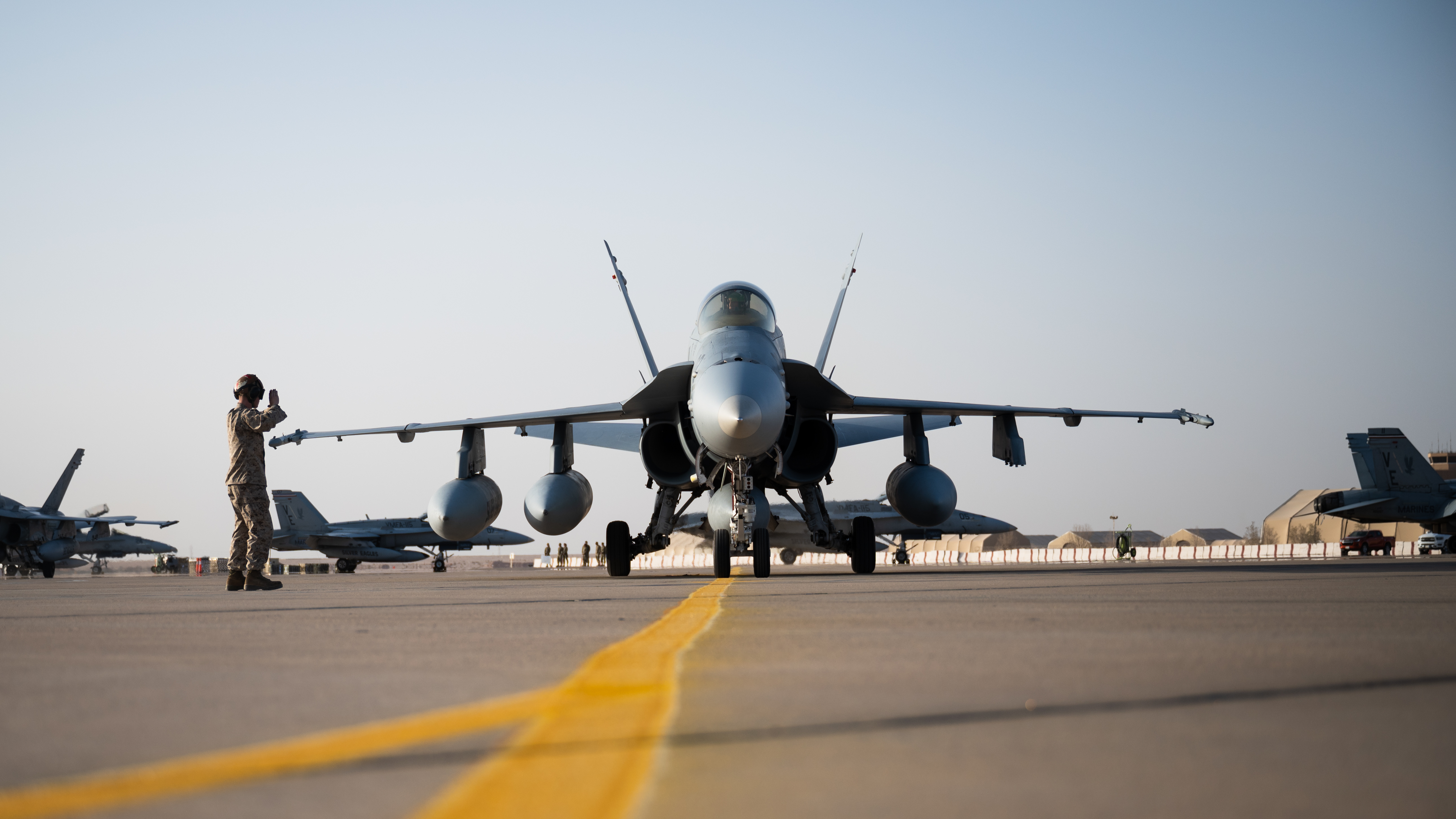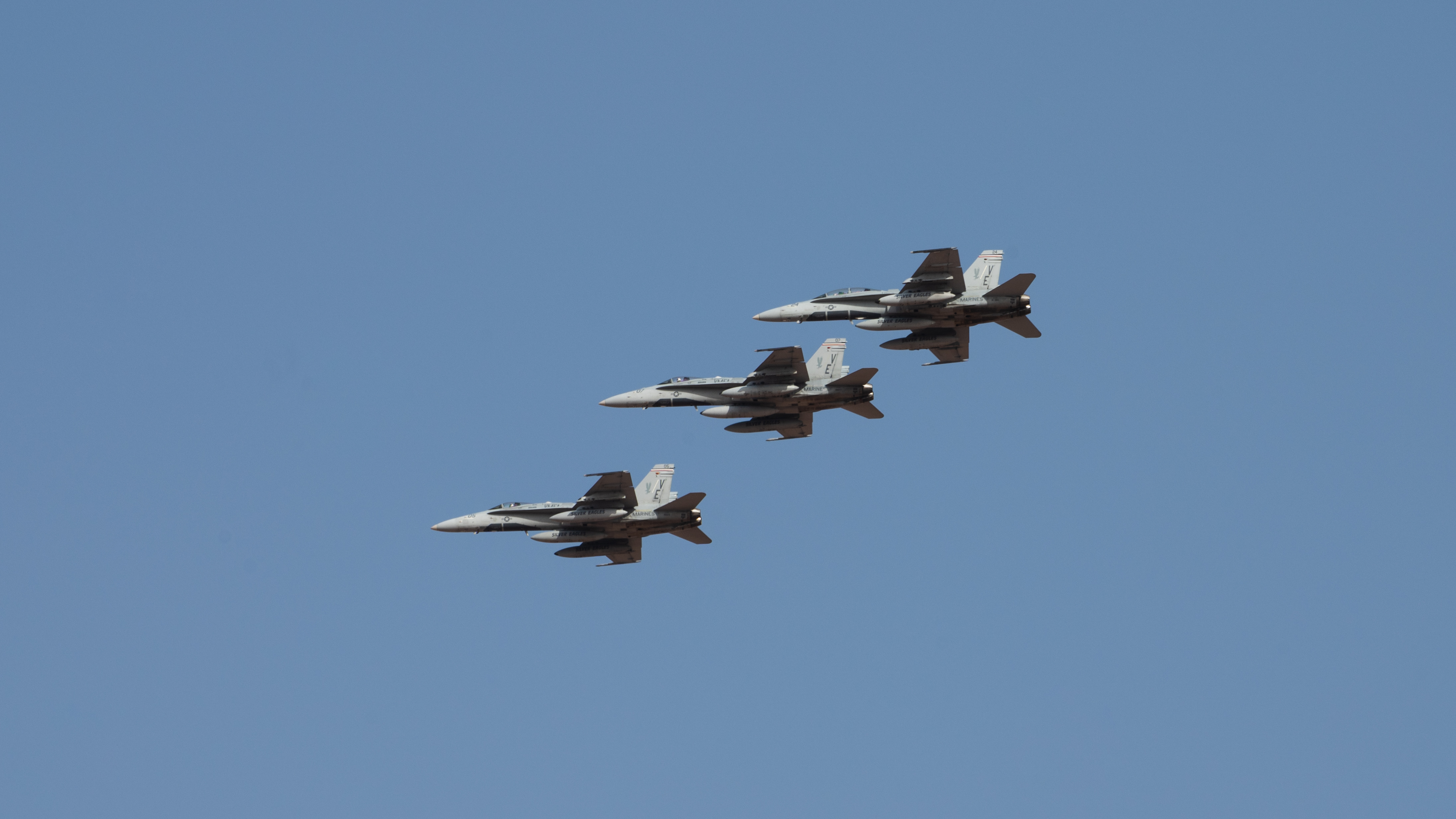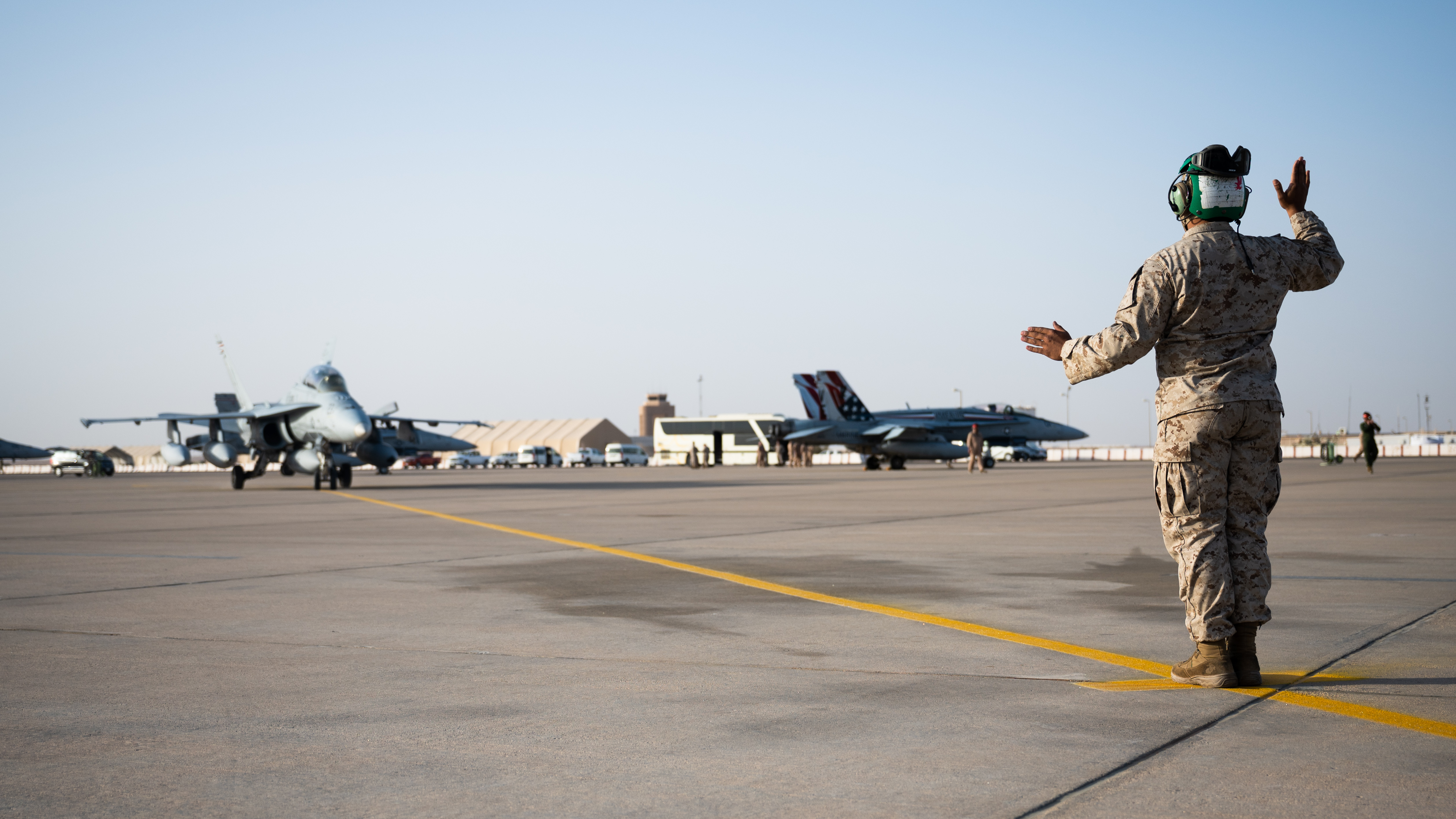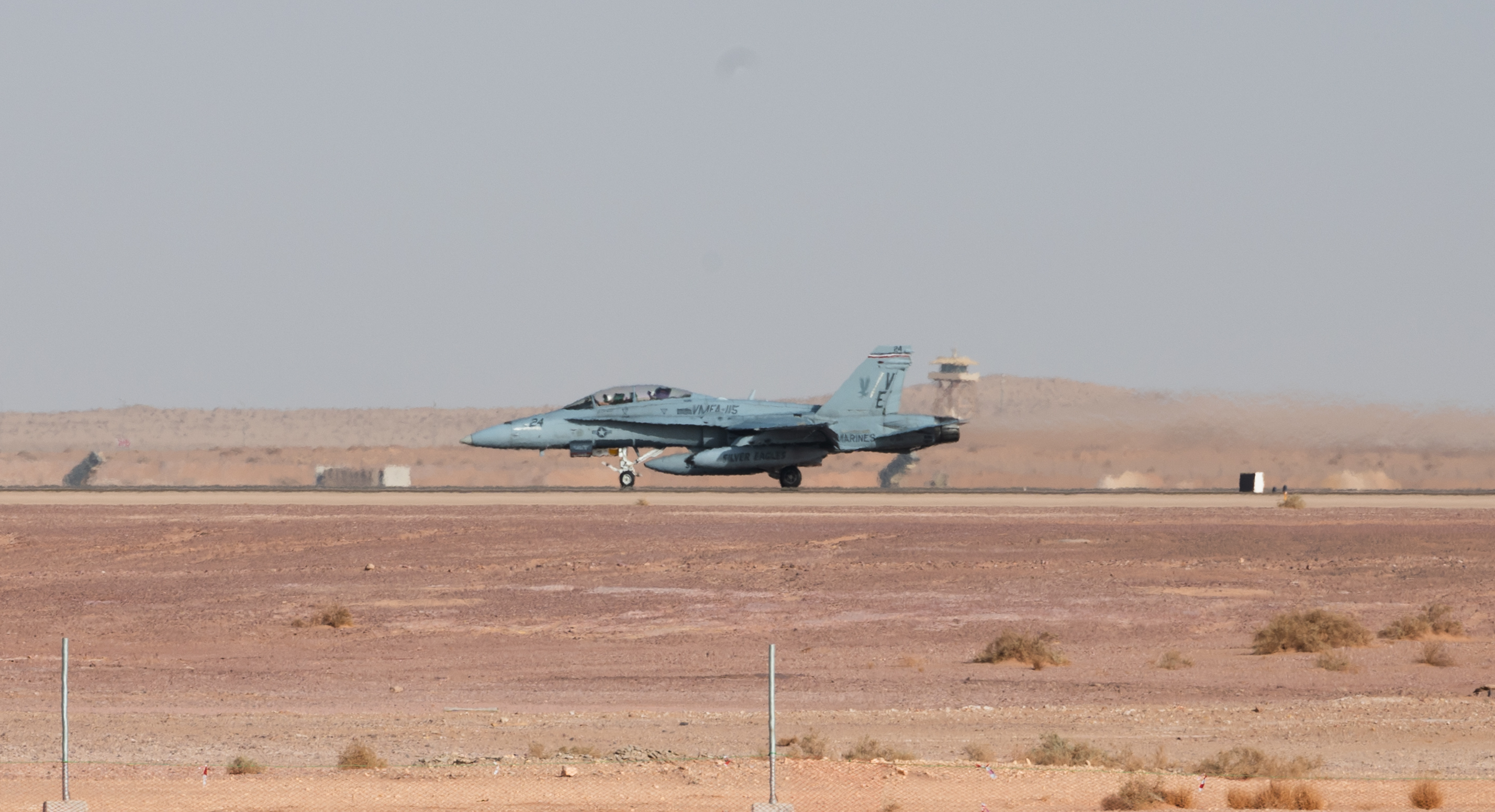Marine Fighter Attack Squadron 115, or VMFA-115, the “Silver Eagles,” has deployed its F/A-18C/D Hornet fighter jets to Prince Sultan Air Base in central Saudi Arabia to bolster U.S. Central Command’s (CENTCOM’s) continuing presence in the country. The arrival of the U.S. Marine Corps ‘Legacy’ Hornets — home-based at Marine Corps Air Station Beaufort, South Carolina — helps maintain the Pentagon’s significant footprint in Saudi Arabia, which has been paralleled by an escalation in Iranian-linked militant activity directed against the Kingdom in recent years.
Images of the deployment were published today by the Defense Visual Information Distribution Service (DVIDS), although VMFA-115’s jets touched down at Prince Sultan Air Base, or PSAB, on December 23. The accompanying release stated that the “Silver Eagles” arrived there “to maximize regional capabilities in regard to mutual security concerns.”

“Strategically from this location, we enhance the Combined Forces Air Component Commander’s flexibility and available assets to fluidly move around the theater,” said Lt. Col. Tim Miller, the VMFA-115 commander. “We bring a long and short-range strike and defensive counter-air capability that bolsters the credible combat power that we look to project in concert with our partners and allies to further stabilize this region.”

At PSAB, the Hornets of VMFA-115 come under the control of the Air Force’s resident 378th Air Expeditionary Wing, or 378th AEW, which was established back in November 2019 as part of a larger U.S. military buildup in Saudi Arabia. Its creation followed a series of unprecedented cruise missile and drone attacks in September that year, linked to Iran, that targeted two major oil-related sites in the Kingdom. Before the end of 2019, Air Force F-22 Raptor stealth fighters and B-1B Lancer bombers, and U.S. Army Patriot missile batteries had all spent time at Prince Sultan. More recently, Air Force F-16 fighter jets from several units have deployed to PSAB and examples remained there as of late December.
As well as the missions outlined, it’s possible the Hornets might also conduct patrols in and around the Persian Gulf, with an eye especially on maritime movements by Iran’s Islamic Revolutionary Guard Corps (IRGC) that may threaten American or other friendly naval vessels or commercial shipping. In the past, these kinds of sorties have also been flown by Air Force F-15E Strike Eagles.
VMFA-115 Hornets pass through Morón Air Base in Spain, en route to PSAB:
The 378th AEW was set up originally to strengthen U.S. forces in Saudi Arabia, signaling a more robust and long-term presence in the Kingdom and making them better able to respond to regional crises, as well as undertaking joint training opportunities. Importantly, the wing was always intended to function as a joint force, allowing these Marine Corps jets to integrate seamlessly under an Air Force headquarters. There is also an inbuilt capacity for the rapid influx of all kinds of air assets in a crisis.

At the time, the Pentagon made it abundantly clear that the development was at least connected to Tehran’s activities in the region, an official release stating: “The United States does not seek conflict with the Iranian regime, but we will retain a robust military capability in the region that is ready to respond to any crisis and will defend U.S. forces and interests in the region.”
While this development took place under the previous Trump administration, which enjoyed close relations with Saudi Arabia, it’s notable that the arrangement continues under President Biden. This administration has otherwise taken a more circumspect approach to its dealings with Riyadh, chiefly due to human rights concerns, including in the conflict in Yemen.
Since the establishment of the base, tensions between Iran, the United States, and U.S. allies and partners in the Middle East have not gone away, although there has still been a drawdown of American forces from the region. This has affected Iraq, in particular, where around 2,500 U.S. troops remain in a mainly advisory capacity.
At the same time, however, the IRGC continues to wage a campaign of attacks on commercial oil tankers in the Gulf of Oman and has seized oil tankers in the strategic Strait of Hormuz.

Meanwhile, the Iranian-backed Houthi militia has also been very active, with various kinds of attacks on commercial and military vessels in the Red Sea, and in the Gulf of Aden, including using explosive-laden unmanned suicide boats. Only yesterday, the Houthis seized an Emirati-flagged vessel in the Red Sea, which had been carrying a Saudi military cargo from the island of Socotra in the Arabian Sea.
At the same time, the Houthis have kept up a campaign of drone and missile attacks against civilian targets, launched into Saudi Arabia from neighboring Yemen. At the end of last year, American and Saudi officials stated that the Houthi drone and missile onslaught against the Kingdom comprised almost a dozen ballistic missile and drone strikes on Saudi territory each week, a considerable uptick compared to 2020. Indeed, such is the tempo of these attacks that Saudi Arabia has begun to run low on its stocks of missile rounds for its U.S.-supplied Patriot air-defense systems and the AIM-120 Advanced Medium-Range Air-to-Air Missiles, or AMRAAMs, that arm its fighter jets.

As for the jets that VMFA-115 has brought to PSAB, these are a mixture of single-seat F/A-18C and twin-seat F/A-18D versions, reflecting the shift to ‘composite’ squadrons that the service introduced a few years ago, and which we covered exclusively at the time. As we have also discussed in the past, these jets are still very capable despite their age, having undergone various upgrades. These are set to continue, to ensure the Legacy Hornet remains on the Marine Corps front line until 2030.

The arrival of Marine Corps Hornets in Saudi Arabia reflects the continued role of the 378th AEW to signal U.S. military intent and capabilities and to respond to regional contingencies as soon as they develop. With tensions between Saudi Arabia and Iran — and Iranian proxies — showing no signs of abating, the VMFA-115 deployment is unlikely to be the last of its kind, as part of what is now a long-term U.S. military presence at Prince Sultan Air Base.
Contact the author: thomas@thedrive.com
